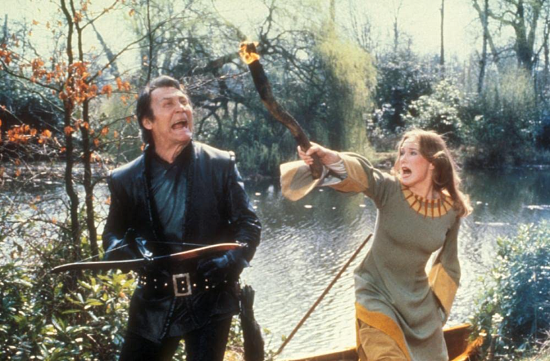Hawk The Slayer
“If you steer clear of quality, you’re alright.”
Pete Townshend
It is called The Glory, and it exists outside of your outrage and your judgment. Outside of nominations and budgets and time. Outside the "language of cinema". It’s there when Ator fights his chrome-skulled twin Trogar under the heat of a Spartan sun. When the evil Voltan, bathed in crimson light, implores the sorcerer to heal his shattered visage. When the Deathstalker sits brooding in the mead hall of Munkar’s fortress. You cannot saddle it or tame it. Or drain its elements into your mise-en-scene. It thrives outside of attention to detail, outside of irony, outside of respectability and artful construction. It is brutal and hilarious and if it is unintentional, then a mountain is an accident.
It is a strong truth that most films would be improved with the addition of a scene in which warriors on horseback attack a village. If, however, you happen to think that a film already replete with a scene of warriors on horseback attacking a village would be improved with the addition of another scene of warriors on horseback attacking a village, then your genre, even if you don’t know it yet, is sword and sorcery. And you are a loser.
For those cosmopolitan enough not to know, and according to popular perception, sword and sorcery is fantasy’s horny idiot brother. It consists of all the basest elements of Tolkien’s Lord Of The Rings trilogy – the fighting, the questing, the wondering what was up Lady Galadriel’s skirt – boiled down into a brackish grog suitable only for libidinally enraged teenagers and people who breathe exclusively out of their mouths. As most would have it – on those rare occasions when "most" give a shit – sword and sorcery is an occasionally entertaining but intellectually moribund branch of medieval fantasy. If, as the genre historian Mick Garris has observed, horror is a "gutter genre"’ then sword and sorcery is thrashing around at sewer level, drinking its own refuse for the entertainment of mice. Put simply, the idea of "elevated" sword and sorcery is ridiculous.
But this is bullshit.
Even at its very, very worst (and it can get very, very bad), sword and sorcery has enough inherent high weirdness, enough lightning-struck, do-it-right-now-don’t-think energy to push it to visionary heights. Simple enough in construction to bend to a lunatic’s will, bold enough to always be recognisable, sword and sorcery’s limited set of influences and blinkered worldview provide a ready-primed canvas for all kinds of strange textures and eruptions of irregularity.
But what is sword and sorcery? And how does it differ from traditional fantasy? The answer is simple: tits.
But before we get to those, a working definition. It was the American author Fritz Leiber who, in 1961, coined the term "sword and sorcery" in order to describe the kind of stories written in the 1920s by Robert E Howard, creator of Conan The Barbarian, whom I imagine even the least fantasy-inclined among you have some inkling of. Howard’s stories still provide the template for the genre: fast paced, full of violent …


